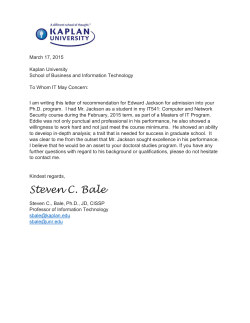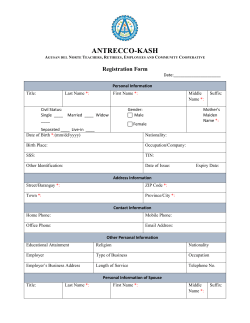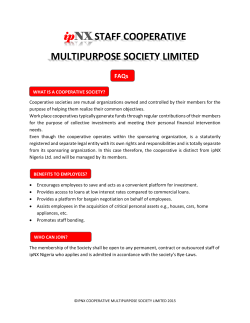
Watts Inside: - Maquoketa Valley Electric Cooperative
March 2015 For Our Members Voluntary and Open Membership Baling for a Cure Why this principle still applies to electric cooperatives “We want to improve our farming methods When electric cooperative members look at the seven cooperative in a way of which principles, many may question if they really live up to the first principle: we can be proud.” Voluntary & Open Membership. It is a fair question. There is a two-part answer. First, it is important to remember that when MVEC was first being formed back in 1935, every potential member had the option to refuse service. While it may be hard to believe today, there are numerous stories from electric cooperatives throughout the country where the farmer said, “No thanks. We are doing fine with kerosene.” Of course over time they changed their minds and eventually became members of the Cooperative. Mark Knuth, Cascade Page 4 Due to the incredible cost of offering electric service, the vast majority of people and businesses only have one choice if they want to connect to “the grid” and receive electricity. While that may change in the future due to other generation sources, the best option for most people for safe, reliable and affordable power is from your electric cooperative. Today, electric cooperatives focus on the second part of the principle, “Open Membership.” All residents and businesses in the service territory of MVEC are welcome to receive power. Cooperatives continually strive continued on page 2 Member Appreciation Nights April 7 5:30 p.m.-7:30 p.m. Lawrence Community Center Anamosa April 9 5:30 p.m.-7:30 p.m. Delaware County Community Center (on the Fairgrounds) Manchester Food! Family! inting Watts Inside: Momentum Is Building Conference Page 2 National Ag Day Page 3 Make Efficiency Affordable Page 3 Baling for a Cure Page 4 Fun! Face Pa The easiest and most cost-effective way to insulate your home is to add insulation in the attic. Pull the Plug Page 5 Balloon Sculptin Bucket g Rides r (weathe ng) permitti Member Appreciation Nights Implementing Quality Surge Protection Page 6 Fact or Fiction Page 7 Momentum Is Building Conference Local building professionals attend energy efficient building conference The annual Momentum Is Building conference, sponsored by Iowa’s Touchstone Energy Cooperatives and the Iowa Energy Center, was recently held in West Des Moines. Attendees included cooperative staff and building professionals from across Iowa, including electricians, HVAC professionals and building contractors. Topics addressed at the conference included: The two-day conference focused on energy efficient building practices by nationally known speakers, displays of the latest building products and techniques, and networking among the building professionals and electric cooperative staff. * Remodeling for energy efficiency * Improving homes for energy efficiency, while providing a safe, healthy environment for residents * Electric Code updates and conserving energy * Geothermal troubleshooting and hydronics * Electrical service for agricultural lighting * Planning building projects for energy efficiency Several of the sessions provided continuing education credits for the attending professionals. Gary Weber, MVEC Member Advocate says, “Each year MVEC participates in the conference, along with our local building trades professionals to learn new energy efficient techniques and building science principles that can be applied to building and remodeling projects in our community, as well as have an opportunity to check out exciting new products, such as new geothermal technology.” To learn more about attending Momentum Is Building in the future, contact Gary Weber at 800927-6068. MVEC area contractors joined MVEC’s Gary Weber and Al Schilling (at left) at the Momentum Is Building Conference. Voluntary and Open Membership All cooperatives, whether it is your credit union, farm cooperative, telephone cooperative or any other of the 29,000 cooperatives that exist in the U.S. today, live by these seven cooperative principles: continued from front page to ensure that your membership has value to you not just through the service of electricity but by being an active part of your community. Cooperatives offer and welcome your participation in the governance of the organization through a democratically elected board of directors. As a locally owned and controlled utility, cooperatives are in a better position to understand the needs of its members and can be quicker to react to help ensure the membership receives the best service possible. Members are welcome to suggest improvements to the Cooperative’s operations and, unlike large investor owned utilities often with millions of customers, you can be assured your ideas will actually be read by a real person in real time. 1. Voluntary & Open Membership 2. Democratic Member Control 3. Members’ Economic Participation 4. Autonomy & Independence 5. Education, Training & Information 6. Cooperation Among Cooperatives 7. Concern for Community 2 By using all of these principles integrated together, MVEC is able to serve your needs every day. National Ag Day Make Efficiency Affordable National Ag Day is March 18, 2015. It’s a time when producers, agricultural associations, corporations, universities, government agencies and countless others across America gather to recognize and celebrate the abundance provided by American agriculture. If you have purchased a new appliance recently, you probably found yourself comparing the annual energy consumption of various models. You probably also noticed that efficiency costs extra. When it comes to appliances, water heaters and HVAC systems, consumers face a classic dilemma: pay now or pay (more) later. The answer is simple: Make efficiency affordable. Energy efficiency is part of Maquoketa Valley Electric Cooperative’s DNA. More than 95% of electric cooperatives nationwide offer efficiency programs. As consumer-owned, not-for-profit utilities, cooperatives are constantly looking for ways to keep members’ bills low, including programs to make high-efficiency appliances and equipment more accessible. As the world population soars, there is even greater demand for the food, fiber and renewable resources produced in the United States. Maquoketa Valley Electric Cooperative offers incentives on insulation and ENERGY STAR® rated clothes washers, water heaters, and air source heat pumps. We also offer home energy assessments to members. The assessment will provide you a report outlining suggested improvements and your return on investment information. For more information on rebate requirements and the energy assessment, call our office at 800-927-6068 or visit www.mvec.coop. The National Ag Day program believes that every American should: 1. Understand how food, fiber and renewable resource products are produced. 2. Value the essential role of agriculture in maintaining a strong economy. 3. Appreciate the role agriculture plays in providing safe, abundant and affordable products. 4. Acknowledge and consider career opportunities in the agriculture, food, fiber and renewable resource industries. Working together at the national level, electric cooperatives advocate for federal policies and programs that can reduce the upfront cost of energy efficiency. Agriculture provides almost everything we eat, use and wear on a daily basis, and is increasingly contributing to fuel and other bio-products. Each year, members of the agricultural industry gather together to promote American agriculture. This effort helps educate millions of consumers. At Maquoketa Valley Electric Cooperative, we want our members to be armed with the information they need to make cost-effective investments in efficiency. Good information will lead to smart choices not only about appliances but about efficiency upgrades. A good place to start is online at TogetherWeSave.com, where members can conduct an interactive energy audit and gain access to a library of energy-saving how-to videos. By far, the most effective part of this program is the role you play in helping spread the word. A few generations ago, most Americans were directly involved in – or had relatives or friends involved in – agricultural-related endeavors. Today, that is no longer the case. That is why it is so important that we join together at the community level…our voices, in concert, become a shout that carries our message a great deal further than any one of us can do alone! 3 We understand there is no such thing as a one-sizefits-all efficiency solution. Our staff can help you sort out which energy efficiency investments make sense for you and your situation. Maquoketa Valley Electric Cooperative strives to be a trusted energy partner for every single one of our members. So come talk to us about how we can help save you money! Baling for a Cure Grace Zimmerman, Anamosa, Iowa It was a rainy Monday morning when, as I usually do when told of new ideas, methods, and bold entrepreneurs, I found myself following up on my latest lead for Watts Current readers. It was the MVEC guys themselves that brought the impetus of the Bale Barn in Cascade, Iowa, to the forefront. Just north of Highway 151 and clearly visible from the thoroughfare stood a big, red building flanked by two semis emblazoned with the Bale Barn’s company logo and motto: “Baling for a Cure.” Within these doors, business managing partner, Mark Knuth, and a handful of employees were hard at work taking large round bales straight from Knuth Farms, Inc.’s, own fields and turning The Bale Barn in Cascade. them into small square bales perfect for livestock and hobby farmers alike. True to his hardworking character, as I pulled up to the Bale Barn for our tour and interview, Knuth was in the middle of one of the last steps: using a Bobcat skid loader to prepare the small squares for sale and shipping and moving them to the building’s 150’ x 90’ temporary storage facility. Once Knuth’s job was complete, he took me to the baler itself to explain all the steps of the baling process and how the men and machines came together. Starting at the first step, large round hay or straw bales made by Knuth Farms wait their turn on a conveyor. The conveyor moves each bale forward to step two: unrolling. Each round bale is unwrapped and then unwound in the same order it was baled so all that is left is the grass or straw itself. The resulting material is then forced through the steel tedder, which I called the “inner workings” of the process. This phase takes the straw or hay that had been flattened due to the intense pressure of the large round bale and fluffs it in order to simulate a natural winrow to feed the small square baler more Small square bales being formed. evenly. It is at this point that the small squares are formed. Once the small squares emerge, they are pushed into a bundler which ties them together 21 at a time. The resulting bundles are then taken to the warehouse and stored on concrete slatted floors so air can ventilate the hay allowing for maximum quality. Knuth explains, “Bales work better if they’re stored awhile, a natural curing process occurs. It doesn’t work very well to take them The bundler ties 21 bales right out of the field.” together. 4 At this point, Knuth points out the control room, a large box-like structure raised off the floor a few yards away from the baler setup, where one of the Bale Barn employees can observe and troubleshoot all the action from beginning to end. I stepped inside to observe Jason Zalaznik, a six-year employee of Knuth Farms, at the electrical controls. If something isn’t working correctly, it’s up to him to stop the process and correct it. “One thing depends on another,” explains Knuth. Each phase of the unrolling, rebaling, and bundling is closely monitored and controlled to maintain consistency of product. It was not unusual to see one of the men notice a small bale had fallen apart, at which point he would quickly pluck it out of the assembly line and At right is the control room where bring it back to the employees can observe the baling proper position to process from beginning to end. start its journey over again. “Two guys can run it, with one being in the control room. We usually have three, but today there are four at work. The employees are part of our farm operation,” stated Knuth. “We want to improve our farming methods in a way of which we can be proud. Our goal is to raise crops and use the end rows for our hay crop. As the business grows, I want to keep employees around, focus on being right, and providing year round work.” Growing the business and perfecting their product is a learning curve that Mark; his wife, Cathy; his sons, Ryan and Eric; daughters, Amanda and Kayla; and their employees have worked to perfect in the past three years of the Bale Barn’s existence. (formerly Families of SMA) helped the family learn how to best meet his needs. “I just felt I wanted to do something for SMA funding, which has been such an important part of working with my grandson’s quality of life. So the baling for a cure operation began as a result.” A percentage of each bale sold from the Bale Barn is donated to SMA research and funding, helping families just like Knuth’s. “I heard about someone in Arkansas doing this. It seemed there was a demand for a similar product around here because of the large number of acreages in the area. So I went down to Arkansas to see it in action, and about three years ago, I brought it back home,” Knuth explained when questioned about his business’ beginnings. In past decades, small square bales were the norm, but as technology advanced, balers became bigger and bigger, resulting in an abundance of the large round bale variety. Thus small bales, which are ideal for small livestock and hobby farmers, were hard to come by. Knuth felt that by bringing the Bale Barn operation to Cascade, he could supply area farmers who needed such a product. As an ole’ farm gal, I told Mark that I thoroughly enjoyed my time at the Bale Barn. The smell of the hay and dust brought back memories of my own time as a girl breaking twine, but I do have to admit it was a noisy, messy process! It was definitely a learning experience, and I hope readers of Watts Current will be able to get the gist of the procedures involved. “We really are glad to be a part of Maquoketa Valley Electric Cooperative,” Knuth stated. “They’ve been a big part of our operation which wholly depends on the great service which they provide.” A business man by nature, Knuth also saw an opportunity to help raise money for a cause close to his heart. In July 2010, Knuth’s grandson was diagnosed with spinal muscular atrophy, a neuromuscular disease that affects the motor nerve cells in the spinal cord and prevents diagnosed individuals from walking, swallowing, or even breathing. It is the number one genetic killer of infants with 1 in 10,000 babies born with one of the four types of SMA. One in 50 Americans are carriers of this genetic disease, many of whom don’t even know it (“About SMA”). Such was the case for Knuth’s family, and upon learning of their grandson’s diagnosis, the organization Cure SMA A final reminder—square bales of grass, alfalfa/ grass mix, and straw are available year round, offering both pick-up at the Bale Barn located at 1193 Farley Road in Cascade or on-site delivery. To find out more about “Baling for a Cure” or to observe the Bale Barn in action, contact Mark Knuth at 563-590-9983 or email mknuth@yousq. net. I assure you that you’ll enjoy his outlook on the family business and goals in life. His son and business partner Ryan Knuth can also be contacted at 563-543-7216, or you can visit their website at www.balebarn.com for more information. Pull the Plug Do you have old appliances no longer in use and taking up space? We can help you recycle them! The Pull the Plug program pays you for saving energy responsibly. Appliances in working condition will qualify for the following rewards: 5 Window AC Refrigerator Freezer $25 $35 $25 Sign up today by calling MVEC at 800-927-6068. Our program contractor, Conservation Services Group, will call you to schedule a collection time for your appliance to be recycled. (Limited to three appliances per year.) Implementing Quality Surge Protection There is little, if anything, you can buy today that does not have some electronic component. Now is the time to take a look at making sure your electronics last as long as possible from electrical surges. devices that allow themselves to be destroyed rather than allowing the surge to pass through. Noble devices indeed! The third prong is to protect expensive devices at their point of use. Computers and entertainment equipment are prime examples. Remember that surges can enter the home via avenues other than the power lines. Computers and entertainment equipment are frequently connected to cable and phone lines. Those devices need to have protection at the point of use that covers all possible avenues. These are generally in the form of a power strip or wall device most of us are familiar with. Use a quality product from a manufacturer such as Monster, Belkin, Tripp Lite, or APC, to name a few. Look for one with a joule rating of at least 1,000, a connected equipment warranty and compatibility with digital signals from cable and satellite. While you are at it, look for a “smart” strip that turns off all but one connected device when not in use. The first order of business is to define a surge. Alternatively known as a line surge, a surge is an unexpected increase in voltage in an electrical current that causes damage to electrical equipment. For example, the standard United States voltage is 120V. If an electrical current above this rating was to come through a power outlet for more than three nanoseconds, this would be considered a surge. Anything less is considered a spike. A surge is usually created by lightning and can damage unprotected computers and sometimes even protected computers. Many people think a blink from Maquoketa Valley Electric Cooperative’s system is a surge, but these are generally caused by something like a tree contacting a line. In such cases, the system’s protective devices work, causing an interruption to protect the wires and other components. These are not surges, but more like turning a light off and on. True surges will enter a home through any number of avenues. The most obvious is through the power lines. Less obvious is through the telephone lines, cable/satellite connections, water lines and any other metallic system that connects to your home. So, to protect against surges, you need to take a three-pronged approach. Save money on your electric bill while protecting your equipment. It’s a definite win-win. 2015 Tri-State Home & Builders Show Perhaps the most important thing to do is to be sure all the grounds in your home are good and that they are bonded together. Over the years, grounds can deteriorate, new services can be added with inadequate grounding and so forth. A faulty ground will allow surges into the home rather than bleeding them off into the earth. Get a qualified electrician to test and correct your grounding system. Next, protect your electrical service entrance with a surge device. They can be mounted at the main electric panel. When a surge travels down the electric lines, these devices will act to “clamp” the surge and reduce its power. These are sacrificial Grand River Center Dubuque, IA March 6: 5-9 p.m. March 7: 10 a.m.-6 p.m. March 8: Noon-5 p.m. MVEC members thinking about building, remodeling, or looking for ways to save money on their electric bills, should plan to stop by our booth (#176). 6 Fact or Fiction Myths About Electrical Safey Sometimes conventional wisdom, even if it comes from a trusted source can be deadly—especially if it pertains to electrical safety. This is one time that checking facts just might save your life. Here are some common electrical safety myths and the truth behind them: • MYTH – A downed power line will be arcing and smoking if it still has power. FACT – Power lines do not automatically shut off when they fall and do not necessarily arc, flash, pop, or smoke when they hit the ground. There is no way to know for sure if a line has potentially deadly current running through it unless it has been properly discharged by a utility crew, so stay away from all downed power lines and keep others away. • MYTH – Household current cannot kill you. FACT – Household current can and does kill. Case-in-point, a 10-year-old girl was killed by household current when she touched a lamp while still damp from a swimming pool. Watts The Answer? 1. Member Appreciation Nights are April ___ & ___. 2. There are ___ cooperative principles. 3. A __________ is an unexpected increase in voltage in an electrical current that causes damage to electrical equipment. • MYTH – Power lines are insulated. FACT – The majority of outside power lines are not insulated. The coating you might see on the lines are just weatherproofing that will offer no protection from the electricity flowing through the lines. • MYTH – Light digging in the yard won’t be deep enough to hit any wires or pipes. FACT – Unless you call 811 and have a professional come to your home and locate the utilities, you can never be sure where lines and pipes are buried. Even if you are just planting flowers or a shrub, you might come into contact with power lines that could kill you. Keep in mind that the locations are approximate, so if you are digging near one of the marked lines, do so with caution. • MYTH – Tires insulate my car from electrical dangers. FACT – If a wire falls on your car while you are in it, the tires are not keeping you from being injured by the electricity. You are not being hurt because you are not a path to ground for the electricity—as long as you stay in the car. Once you step out of the car, you become that path to ground and can be seriously injured or killed. If you find yourself in a situation where your car has hit a utility pole or has a power line come down on it, the best place for you to be is in the car. Call for help, and keep others away until a utility crew can kill the wires. If you must exit the car, it is critical for you to make sure not to touch the ground and the car at the same time. Jump out of the car, keeping your feet together. Then bunny-hop away. Source: SafeElectricity.org 7 Mail your answers in with your energy bill or email them to: erobertson@mvec.coop. Two winners will each receive a $10.00 credit on their energy bills. Name: __________________________ Address: __________________________ ___________________________ January winners: Michael Knowles, Bellevue Lisa Lueken, Worthington Maquoketa Valley Electric Cooperative 109 North Huber Street Anamosa, Iowa 52205 ® Printed by Julin Printing Company Monticello, IA
© Copyright 2025









